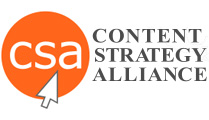Why Content Strategists Should Focus on ROI more than Engagement
“Content people hate to talk about money,” stated Laura Creekmore (pictured above), a content strategist out of Nashville, Tennessee. “It is an unpopular opinion to say that content work isn’t art, but you need to expect that your work will be judged in concrete and objective terms.”
On January 23 in Charlotte, North Carolina, Creekmore gave a talk titled Content 3.0 Making Great Decisions at the TinyGiant UX conference. The audience included UX designers, content strategists and others working in digital media.
Her talk focused on three “lenses” through which we need to view our content work – money, message and mechanics. I suspect the money lens may be the most challenging to conventional thinking in our industry, so let’s consider Creekmore’s ideas about it here.
She mentioned that before beginning a content project, essential questions to consider that impact the bottom line include:
- How many people will this content take to make?
- What skillsets and expertise do you need?
- What kind of training is going to be needed?
- Do you need other professionals integrated with your team? Whose budget does that expense come out of?
- How will the data interact with the content management system?
- What assets and technology do you need for content specific work?
- How will all the parts fit together to achieve the goal?
Creekmore also noted that a big part of the complexity—and therefore cost—of content is its maintenance and updating, so that cost needs to be added into the equation as well.
Considering the above aspects of a content project will help get you to the “expense side” of the ledger, Creekmore explains. She notes that most of us certainly do tally up the cost to develop content. But we must go further, she insists.
“If you want to make things more complex or better or take more time, you might need to justify this to the business side of the house,” Creekmore explained. “These folks aren’t going to get that adding a new section of the website might mean you need a new staffer. They don’t understand these things, you have to translate for them.”
Creekmore strongly recommends that you don’t fall back on a common argument in our industry. She advises:
“Do not, do not, do not make the argument that your content is valuable because ‘It’s engaging!’”
From her nearly 20 years of experience in digital media, Creekmore knows that the engagement argument isn’t strong enough.
“You never win, it’s not quantifiable,” she explained. “You need to think – how do I turn it into dollars and cents?”
According to Creekmore, a content strategist needs to answer this question:
What is the return on investment (ROI) for this content?
“What is the value that content brings to the enterprise?” she asks. “You’ve got to be able to sell the value of what you are doing first – before you talk about the expenses.”
Creekmore suggests content strategists get very specific on the value content brings to the enterprise or product.
She suggested the book “How to Measure Anything: How to Find the Value of Intangibles in Business” by Doug Hubbard as a resource to determine measures for content. Hubbard asserts that anything can be measured and that your professional life may be greatly harmed by a lack of measurement.
“This book can help you turn something that feels like art into a spreadsheet,” she explained. This may help you sell the value of content to other stakeholders in the enterprise.
At the Content Strategy Alliance, we have been working on a handbook with templates that include recommended metrics to help you show the value of content to others. This resource should be available in a couple of months.
Creekmore’s message may not be popular yet, but from a business perspective, it ‘s right on the money. Literally.
Learn more about Laura Creekmore.

